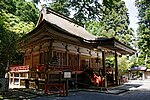|
Jūzenji
Jūzenji (十禅師) is a Japanese deity associated with Hiyoshi Taisha and Enryaku-ji.[1][2][3][4][5] He was seen as a god of male homosexuality.[2] and sometimes seen as being the core god which all things emanated from.[2] He is sometimes seen as having a close relationship with Shuten-dōji.[1]: 198 This is emphasized with his link to white monkeys, the shinshi of Mount Hiei.[1]: 198 He was worshipped as one of the seven key emanations of Sanno Gongen.[2] He was at times seen as being the core god which all things emanated from.[2] He is sometimes identified with Ninigi[2][1]: 215-216 and at other times with Prince Shotoku.[1]: 215-216 or Jizo[1]: 206-207 or as a masculine Benzaiten.[1]: 216-218 His name is derived from a group of ten Buddhist monks, which was a prominent institution in the Heian period, but declined by the time his worship began.[6] It means "Ten Masters of Practice".[7] HistoryJien is said to have possibly had a homosexual love affair with Juzenji.[1]: 198 In one myth every night he came to Jien in the form of a monkey and sat on his shoulder.[1]: 216-218 He was seen as a god of male homosexuality.[2] Juzenji is a complex deity seen as ambivalent both curing and blessing people. He is normally depicted as a youth.[1]: 205 [2] He is compared to Janus in his ambivalent nature.[1]: 223 Tendai chroniclers like Kōshū have written about Jūzenji. They keep his complex nature in their writings. They avoid simplifying him into just a symbol.[1]: 205 The "Sange yōryakki", written by Gigen during the Kamakura period tells of Saichō's first climb on Mount Hiei in 785. There, Saichō met a divine youth. This youth called himself the deity of destiny. He also said he was the divine child and Dōshōjin.[1]: 206-207 Genshin, was a famous monk. He lived from 942 to 1017. His teachings describe Jūzenji. He said Jūzenji was centrally linked to the forces of the universe.[1]: 206-207 The Sannō Mitsuki offers a different view. It says Jūzenji has a dual role in Heaven and Earth. He is Kokūzō in heaven. On earth, Jūzenji is Jizō.[1]: 206-207 The Sange Sairyakki is another text. It talks about Saichō's meeting with the divine youth. This youth had three names. The first is Dōshōten. This means he was born with all beings. The second is Yugyōjin. He oversees the destiny of beings. The third is Jūzenji. He shares Zen's bliss and creates karmic ties.[1]: 206-207 The Sefurisan engi adds to the story. It suggests the youth Saichō met was Oto Gohō. Oto Gohō later protected Saichō on his trip to China.[1]: 206-207 He was sometimes identified as a serpentine deity linked to placenta and identified with Benzaiten.[1]: 216-218 His popularity declined in the Edo period,[1]: 223 and worship ended with the Meiji Restoration.[6] His shrine at Hiyoshi Taisha was renamed as Jugeguu.[8] Link to Prince ShotokuJūzenji and Shōtoku Taishi share similarities. Shōtoku is often shown as a child. He represents the bodhisattva Kannon. In 1069, a ritual at Hōryūji focused on Shōtoku as a seven-year-old. This was different from the usual worship of Guze Kannon. This choice reflects the period's emphasis on youth. It was a time when puppet emperors were under cloistered emperors' control. It was also when Young Prince (若宮, Wakamiya) deities became popular.[1]: 215-216 Such deities were generally linked to Prince Shotoku.[1]: 186 Jien, a poet, revered both Prince Shotoku and Jūzenji. He saw them as almost the same. Jien made many offerings at the Jūzenji shrine. In 1216, he dedicated a vow to Jūzenji and Shōtoku's mausoleum after a dream.[1]: 215-216 Relationship with DaigyōjiDaigyōji is considered Jūzenji's uncle. He is known as an "evil god." He represents Japan's original landlord deities. By the thirteenth century, Daigyōji had a zoomorphic appearance. He is an avatar of Sarutahiko. Some medieval stories replace Ninigi with Jūzenji. The connection between Jūzenji and Daigyōji is explained in the Rō no miko ki. This text is about the origins of Jūzenji shrine mediums, known as the rō no miko.[1]: 215-216 Sarutahiko and Daigyoji also have monkey associations.[1]: 216-218 Artistic depictionJūzenji is not often shown in art. When shown, he is usually a young or middle-aged monk.[1]: 207-212 In the Sannō mandalas, Jūzenji appears with other deities. One description shows him as a monk over twenty years old. He holds a scroll and a fan. Another source describes him as a respected monk in dreams.[1]: 207-212 One painting shows Jūzenji on a platform. A small monkey is climbing stairs towards him. Jizō is above him in a golden circle. The background shows rocks, trees, and seven stars. These stars represent the seven upper Hie shrines. Monks from Mount Hiei mostly worshipped this form.[1]: 207-212 Recently, images of Jūzenji as a youth have been found. There are a few examples. They show Jūzenji with similar features to Jizo. He has a wish-fulfilling jewel and a unique banner holder on a lotus stalk.[1]: 207-212 In popular cultureThe shrine of Juzenji is a setting in The Tale of the Heike.[9]: 60 See alsoReferences
|
||||||

